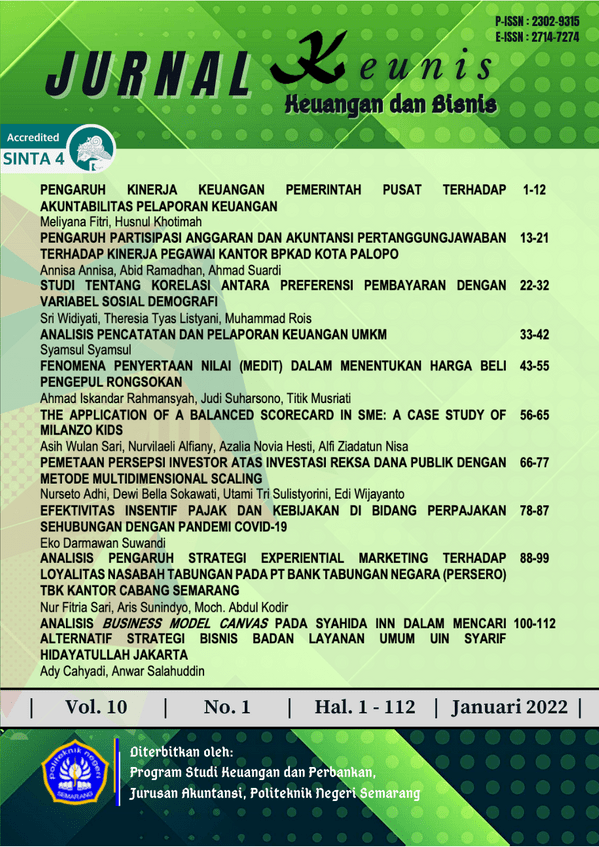THE APPLICATION OF A BALANCED SCORECARD IN SME: A CASE STUDY OF MILANZO KIDS
DOI:
https://doi.org/10.32497/keunis.v10i1.3093Keywords:
balanced scorecard, convection, covid-19, SMEs, strategic managementAbstract
The processing industry is one of the non-agricultural SMEs sectors that ranks at the top in the national economy, of which there are 14.4% of textile and convection industry players (BPS, 2015). According to a survey by the Ministry of Cooperatives and SMEs, during the Covid-19 Pandemic, the convection sector SMEs were the most affected sector with 78% of respondents claiming to have experienced a decrease in revenue and even had to close their businesses. Milanzo Kids is one of the convection SME that was established in 2013, engaged in the manufacture of children's t-shirts made of cotton and located in Jakarta, Indonesia. In 2020, Milanzo Kids experienced a decrease in revenue and profit from the previous year due to the Covid-19 pandemic. The objective of this study is to design a business development strategy using the balanced scorecard method. This research is a type of quantitative research. The data of this study were obtained from primary data through direct interviews and secondary data obtained from financial reports, journals, and books. The data processing method uses a balanced scorecard. The results of this study indicated that total omzet per year and the number of products returned per year has the highest performance, namely the final score of 0.13. While, the lowest performance indicator is the type of product produced with a final score of 0.03.
References
BPS. (2016). Sensus Ekonomi 2016. http://se2016.bps.go.id
David, F. R., & David, F. R. (2017). Strategic Management Concept and Cases. In Strategic Management (Sixteenth). Prentice Hall.
Faizaty, N. E., Trisnowati, Y., Anthony, A., & Sari, E. D. A. (2019). Perancangan Instrumen Pengukuran Kinerja Usaha UKM Kalem Coffe Dengan Pendekatan Balanced Scorecard. Jurnal Manajerial, 6(1), 9”“16.
Gamble, J, E., Peteraf, M, A., & Thompson Jnr, A, A. (2013). Essentials for strategic management: The quest for competitive advantage. McGraw-Hill Education.
Kaplan, R. S. (2010). Conceptual Foundations of the Balanced Scorecard. In Handbooks of Management Accounting Research.
Kaplan, R. S. & David, P. N. (1996). The Balanced Scorecard: Translating Strategy into Action.
Niven, P. R. (2002). Balanced Scorecard Step-by-Step. John Wiley & Sons, Inc.
Panudju, A. T., Asfar, A. H., & Fauziah, F. (2016). Pengukuran Kinrja Perusahaan Menggunakan Metode Balanced Scorecard (BSC) Dengan Pembobotan Analytical Hierarchy Process (AHP) Di PT. ABC, TBK. Integrasi Sistem Industri, 3(December), 55”“65.
Parmenter, D. (2015). Key Performance Indicators: Developing, Implementing, and Using Winning KPIs. John Wiley & Sons, Inc.
Sari, I. A., Wahyuhastuti, N., & Yunus, M. (2021). MSME development strategy in central java province through a swot balanced scorecard analysis approach. Monex: Journal of Accounting Research, 10, 184”“193.
Utama, N. A., & Hariadi, B. (2013). Analisis Pengukuran Kinerja Rumah Sakit dengan Pendekatan Balanced Scorecard (Studi Kasus Pada RSUD Prof. Dr. Soekandar Mojosari). Jurnal Ilmiah Mahasiswa FEB Universitas Brawijaya, 1(2).
Downloads
Published
Issue
Section
License
KEUNIS is licensed under a Creative Commons Attribution-ShareAlike 4.0 International License.
Authors who publish with this journal agree to the following terms:
- Authors retain copyright and grant the journal right of first publication with the work simultaneously licensed under a Creative Commons Attribution-ShareAlike 4.0 International License that allows others to share the work with an acknowledgement of the work's authorship and initial publication in this journal.
- Authors are able to enter into separate, additional contractual arrangements for the non-exclusive distribution of the journal's published version of the work (e.g., post it to an institutional repository or publish it in a book), with an acknowledgement of its initial publication in this journal.
- Authors are permitted and encouraged to post their work online (e.g., in institutional repositories or on their website) prior to and during the submission process, as it can lead to productive exchanges, as well as earlier and greater citation of published work (See The Effect of Open Access).






